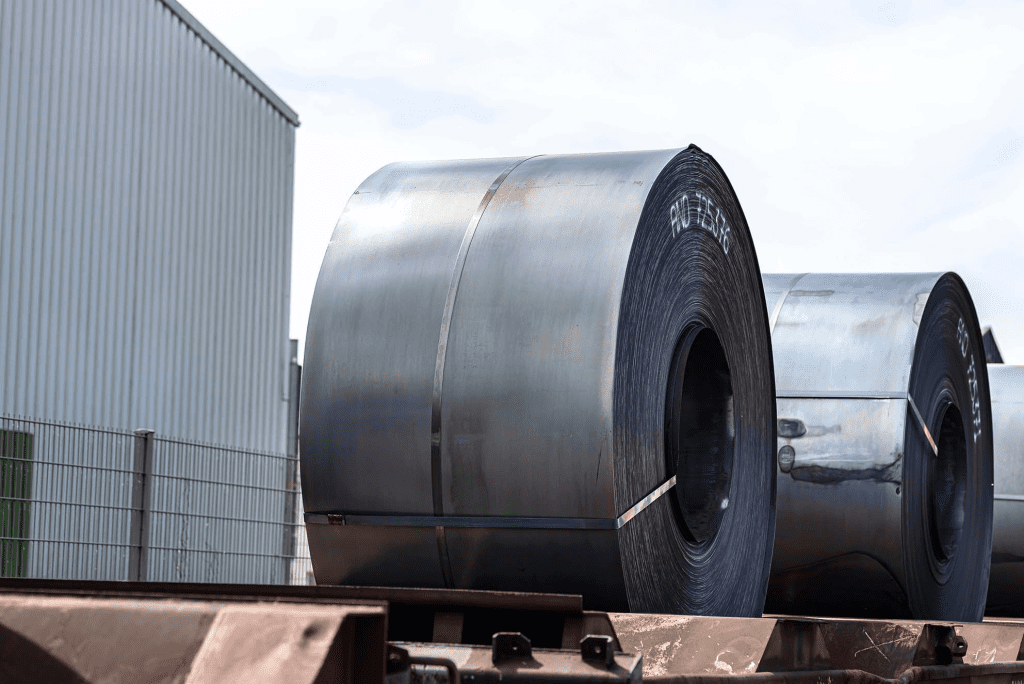Steel coils are a common sight on highways, often seen loaded onto flatbed trucks or trailers. But have you ever wondered why they are sometimes carelessly positioned without adequate securing? Improperly loaded steel coils not only pose a risk to the driver but also endanger everyone on the road. The practice of quickly placing steel coils on a vehicle without taking safety measures can lead to catastrophic consequences.
The Problem with Vertically Stacking Steel Coils

It might seem intuitive to place steel coils vertically because it looks like they take up less space that way. However, this method introduces several critical dangers. When steel coils are stacked vertically, they exert excessive pressure on the transport vehicle’s floor. Due to the smaller contact area between the coil and the surface of the vehicle, the weight distribution becomes uneven, concentrating enormous pressure on a limited area. This can cause the floor of the vehicle to crack or fail entirely, leading to structural damage.
When the pressure exceeds the floor’s maximum load capacity, the result could be disastrous. A damaged container floor may collapse under the weight, and the coils could break loose, creating a hazard for everyone nearby. The first rule of safe transportation is to ensure the vehicle can bear the weight properly, and vertical stacking makes this significantly more difficult.
Why Vertical Steel Coils Are Prone to Rolling
Another critical danger associated with vertically stacked steel coils is their tendency to roll. Coils stacked upright have a high center of gravity, making them more susceptible to movement, especially when the vehicle makes sudden stops, accelerates, or takes sharp turns. Inertia—the resistance of an object to a change in its state of motion—comes into play here. As the vehicle moves, so does the coil, and if not securely fastened, it can easily roll.
Picture a large steel coil, weighing thousands of pounds, suddenly breaking free and rolling around in the cargo area. This creates a deadly scenario for the driver, as the coil could breach the cab, causing fatal injuries. Even worse, if the coil escapes the vehicle, it could barrel into other cars on the road, leading to major accidents or even loss of life. The risks are clear, yet this dangerous practice persists.
The Advantages of Horizontal Steel Coil Transport
In stark contrast to vertical stacking, horizontally positioning steel coils provides a much safer solution. By laying the coil down flat, the contact area with the vehicle floor increases significantly, distributing the weight evenly across the surface. This not only prevents excessive pressure but also lowers the chance of vehicle floor damage. A larger contact area ensures that the load is stable and balanced, minimizing the risk of structural failure.
Moreover, when steel coils are transported horizontally, they are far less likely to roll. Rolling a horizontally positioned coil would require overcoming significant rotational inertia, which is much harder to achieve than with a vertical coil. This makes horizontal positioning the safer option, drastically reducing the chance of the coil moving unexpectedly during transport.
Why Some Transporters Still Choose the Risky Route

Despite the obvious risks, some transporters still opt to load steel coils quickly and unsafely. Why? One reason is convenience. Properly securing a steel coil horizontally requires more time, effort, and equipment. Transporters may need specialized cradles or bracing to prevent the load from shifting, and this additional work may seem inconvenient.
However, the consequences of failing to secure steel coils properly far outweigh any perceived time saved. A loose coil can cause a fatal accident, leading to costly legal battles, vehicle damage, and harm to others. Negligence on the road endangers not only the driver but also the public, making shortcuts in coil loading an irresponsible choice.
The Importance of Securing Steel Coils with Proper Equipment
Loading steel coils horizontally is just the first step. Proper securement is equally essential to prevent movement during transport. This means using heavy-duty straps, chocks, or braces to keep the coil firmly in place. Many transporters use specialized cradles designed to hold the coils securely, ensuring they won’t shift or roll. By taking the time to position and secure these loads properly, you can avoid unnecessary accidents and ensure safe delivery.
Professional drivers and transport companies must follow strict regulations when hauling steel coils and other heavy loads. Regulations like the Federal Motor Carrier Safety Administration (FMCSA) in the U.S. provide guidelines for securing heavy cargo to prevent accidents on the road. Violating these regulations can result in penalties, fines, or even suspension of the company’s transport license.
Why Safety Should Always Come First

At the end of the day, no shortcut is worth the risk of endangering lives. Transporting steel coils requires precision and care. The potential hazards of improperly loading and securing coils can lead to catastrophic consequences on the road. As a driver or transporter, prioritizing safety means taking the necessary steps to ensure your load is secure. It’s not just about compliance; it’s about protecting everyone who shares the road with you.
When steel coils are properly transported, you eliminate the risk of them breaking free, rolling, or causing accidents. By choosing the horizontal method, distributing weight evenly, and securing the load with reliable equipment, you’re doing your part to keep our roads safe. Steel coils may seem like an everyday cargo, but the care with which they’re transported can make all the difference between a smooth delivery and a deadly disaster.


